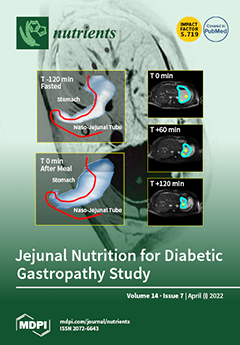Nutrients, Volume 14, Issue 7 (April-1 2022) – 214 articles
Nausea, vomiting, and abdominal pain in diabetic patients are often attributed to gastropathy (DG).
Jejunal nutrition (JN) may improve nutrition and symptoms in difficult cases.
The J4G study tested this hypothesis. DG patients with moderate-to-severe symptoms, diabetic and healthy controls were entered into a randomized, double-blind controlled trial. JN with liquid nutrient or water (placebo) was infused prior to oral ingestion of the mixed solid/liquid “Nottingham Test Meal”.
Post-prandial symptoms were reduced after JN in DG patients. The mechanism is not primarily mediated by specific effects on GE but involved other aspects of GI function, including visceral sensitivity. View this paper
- Issues are regarded as officially published after their release is announced to the table of contents alert mailing list.
- You may sign up for e-mail alerts to receive table of contents of newly released issues.
- PDF is the official format for papers published in both, html and pdf forms. To view the papers in pdf format, click on the "PDF Full-text" link, and use the free Adobe Reader to open them.






